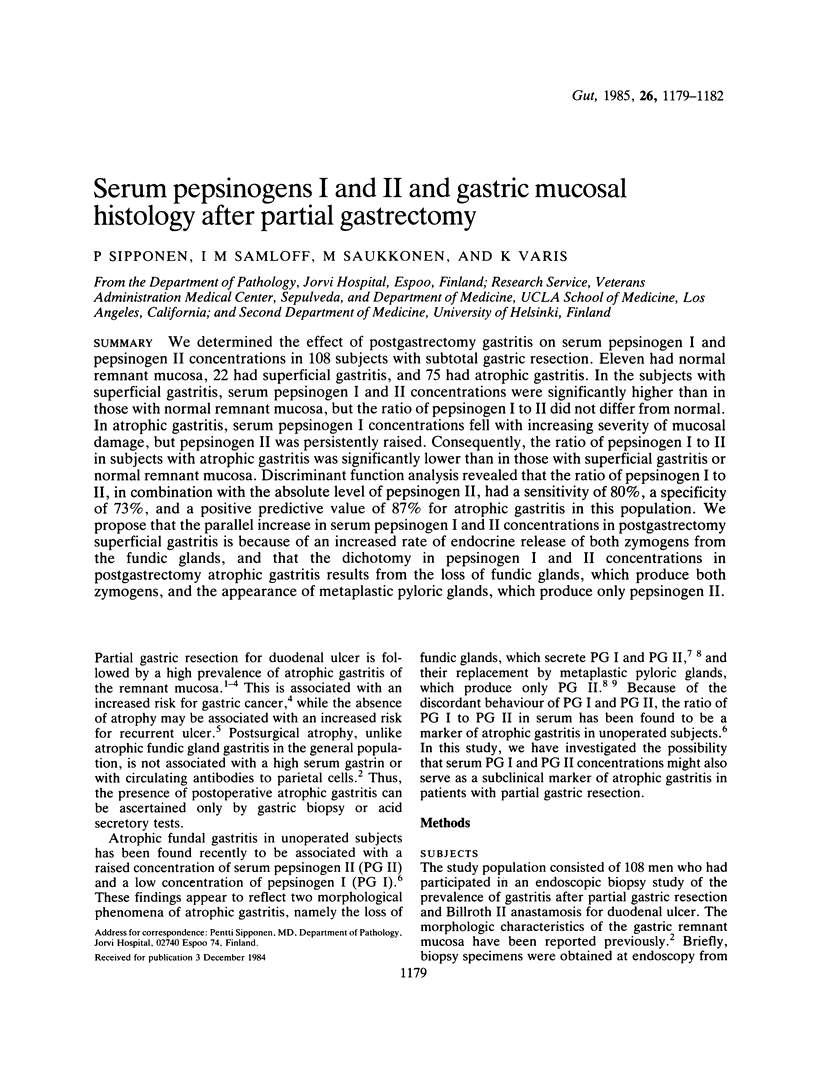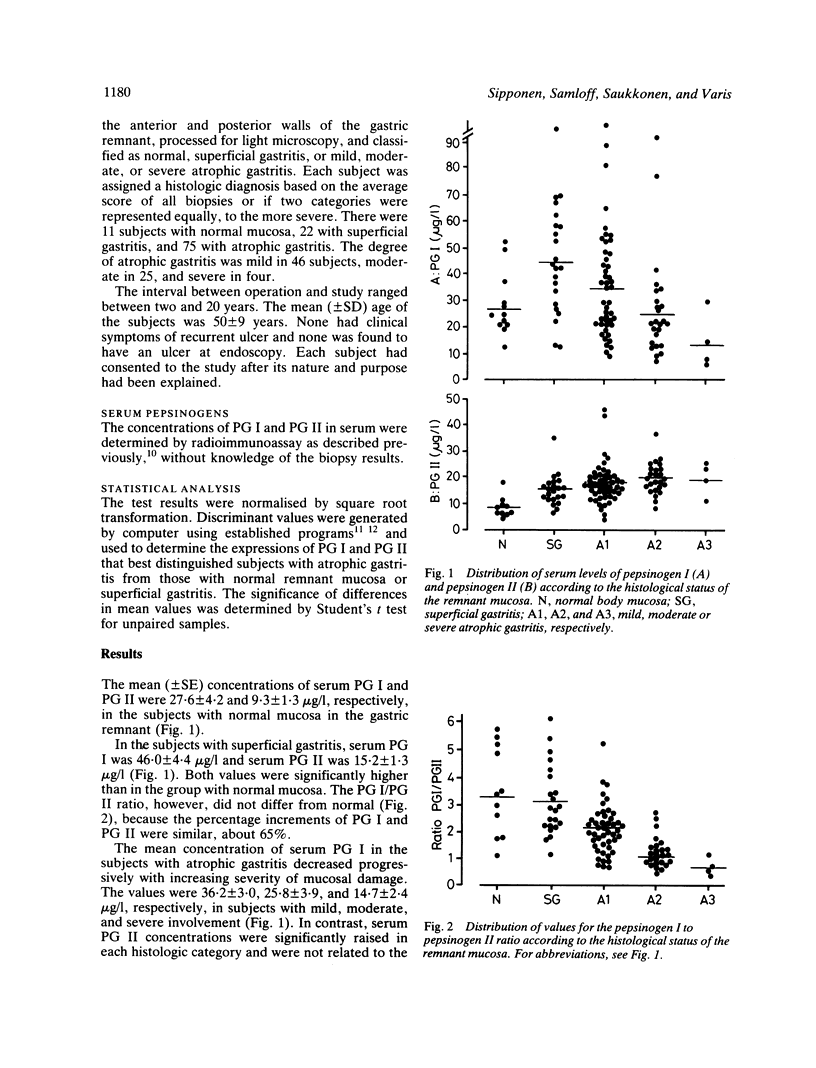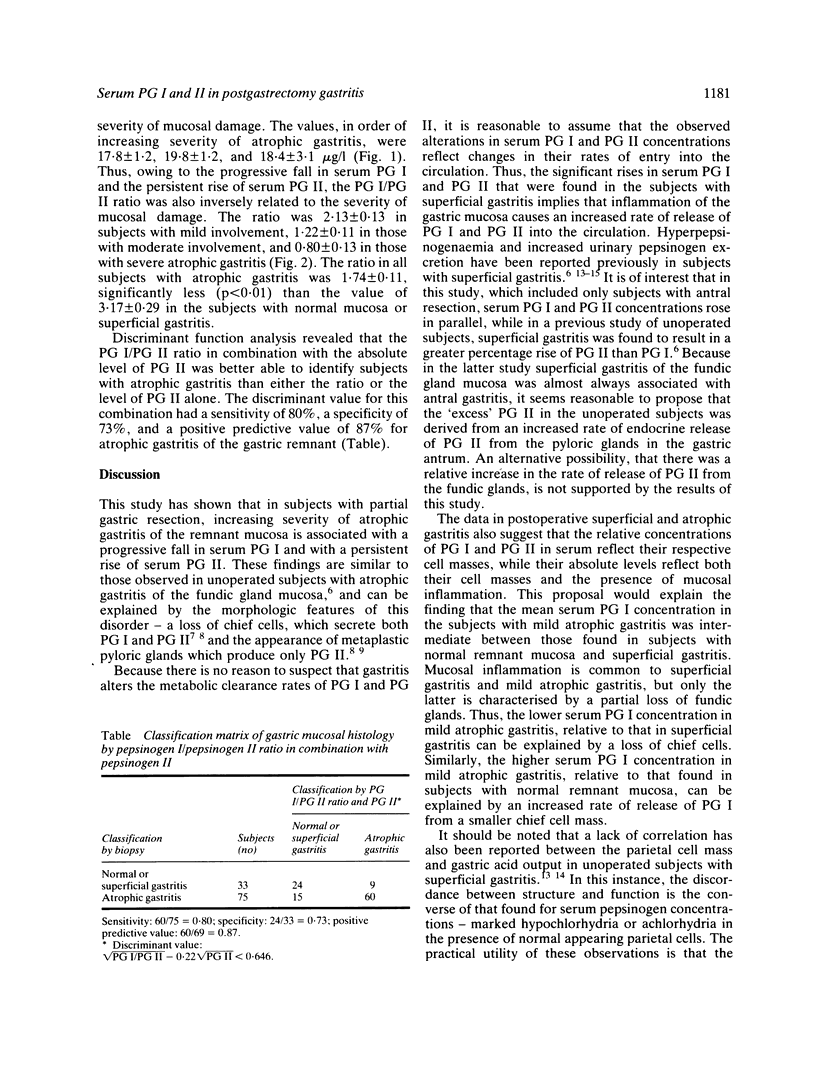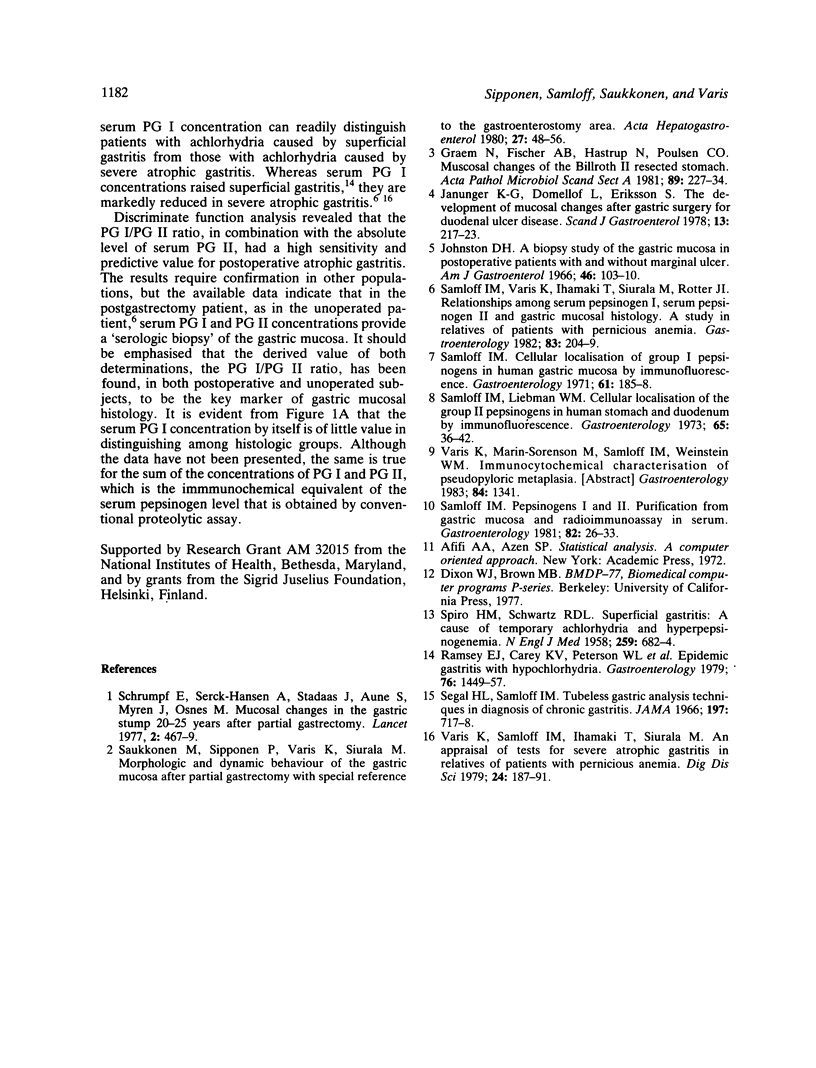Abstract
We determined the effect of postgastrectomy gastritis on serum pepsinogen I and pepsinogen II concentrations in 108 subjects with subtotal gastric resection. Eleven had normal remnant mucosa, 22 had superficial gastritis, and 75 had atrophic gastritis. In the subjects with superficial gastritis, serum pepsinogen I and II concentrations were significantly higher than in those with normal remnant mucosa, but the ratio of pepsinogen I to II did not differ from normal. In atrophic gastritis, serum pepsinogen I concentrations fell with increasing severity of mucosal damage, but pepsinogen II was persistently raised. Consequently, the ratio of pepsinogen I to II in subjects with atrophic gastritis was significantly lower than in those with superficial gastritis or normal remnant mucosa. Discriminant function analysis revealed that the ratio of pepsinogen I to II, in combination with the absolute level of pepsinogen II, had a sensitivity of 80%, a specificity of 73%, and a positive predictive value of 87% for atrophic gastritis in this population. We propose that the parallel increase in serum pepsinogen I and II concentrations in postgastrectomy superficial gastritis is because of an increased rate of endocrine release of both zymogens from the fundic glands, and that the dichotomy in pepsinogen I and II concentrations in postgastrectomy atrophic gastritis results from the loss of fundic glands, which produce both zymogens, and the appearance of metaplastic pyloric glands, which produce only pepsinogen II.
Full text
PDF



Selected References
These references are in PubMed. This may not be the complete list of references from this article.
- Graem N., Fischer A. B., Hastrup N., Povlsen C. O. Mucosal changes of the Billroth II resected stomach. A follow-up study of patients resected for duodenal ulcer,with special reference to gastritis, atypia and cancer. Acta Pathol Microbiol Scand A. 1981 May;89(3):227–234. [PubMed] [Google Scholar]
- Janunger K. G., Domellöf L., Eriksson S. The development of mucosal changes after gastric surgery for ulcer disease. Scand J Gastroenterol. 1978;13(2):217–223. doi: 10.3109/00365527809181751. [DOI] [PubMed] [Google Scholar]
- Johnston D. H. A biopsy study of the gastric mucosa in postoperative patients with and without marginal ulcer. Am J Gastroenterol. 1966 Aug;46(2):103–118. [PubMed] [Google Scholar]
- Ramsey E. J., Carey K. V., Peterson W. L., Jackson J. J., Murphy F. K., Read N. W., Taylor K. B., Trier J. S., Fordtran J. S. Epidemic gastritis with hypochlorhydria. Gastroenterology. 1979 Jun;76(6):1449–1457. [PubMed] [Google Scholar]
- SPIRO H. M., SCHWARTZ R. D. Superficial gastritis; a cause of temporary achlorhydria and hyperpepsinemia. N Engl J Med. 1958 Oct 2;259(14):682–684. doi: 10.1056/NEJM195810022591406. [DOI] [PubMed] [Google Scholar]
- Samloff I. M. Cellular localization of group I pepsinogens in human gastric mucosa by immunofluorescence. Gastroenterology. 1971 Aug;61(2):185–188. [PubMed] [Google Scholar]
- Samloff I. M., Liebman W. M. Cellular localization of the group II pepsinogens in human stomach and duodenum by immunofluorescence. Gastroenterology. 1973 Jul;65(1):36–42. [PubMed] [Google Scholar]
- Samloff I. M. Pepsinogens I and II: purification from gastric mucosa and radioimmunoassay in serum. Gastroenterology. 1982 Jan;82(1):26–33. [PubMed] [Google Scholar]
- Samloff I. M., Varis K., Ihamaki T., Siurala M., Rotter J. I. Relationships among serum pepsinogen I, serum pepsinogen II, and gastric mucosal histology. A study in relatives of patients with pernicious anemia. Gastroenterology. 1982 Jul;83(1 Pt 2):204–209. [PubMed] [Google Scholar]
- Saukkonen M., Sipponen P., Varis K., Siurala M. Morphological and dynamic behavior of the gastric mucosa after partial gastrectomy with special reference to the gastroenterostomy area. Hepatogastroenterology. 1980 Feb;27(1):48–56. [PubMed] [Google Scholar]
- Schrumpf E., Serck-Hanssen A., Stadaas J., Aune S., Myren J., Osnes M. Mucosal changes in the gastric stump 20-25 years after partial gastrectomy. Lancet. 1977 Sep 3;2(8036):467–469. doi: 10.1016/s0140-6736(77)91599-9. [DOI] [PubMed] [Google Scholar]
- Segal H. L., Samloff I. M. Tubeless gastric analysis techniques in diagnosis of chronic gastritis. JAMA. 1966 Aug 29;197(9):717–718. [PubMed] [Google Scholar]
- Varis K., Samloff I. M., Ihämaki T., Siurala M. An appraisal of tests for severe atrophic gastritis in relatives of patients with pernicious anemia. Dig Dis Sci. 1979 Mar;24(3):187–191. doi: 10.1007/BF01308427. [DOI] [PubMed] [Google Scholar]


